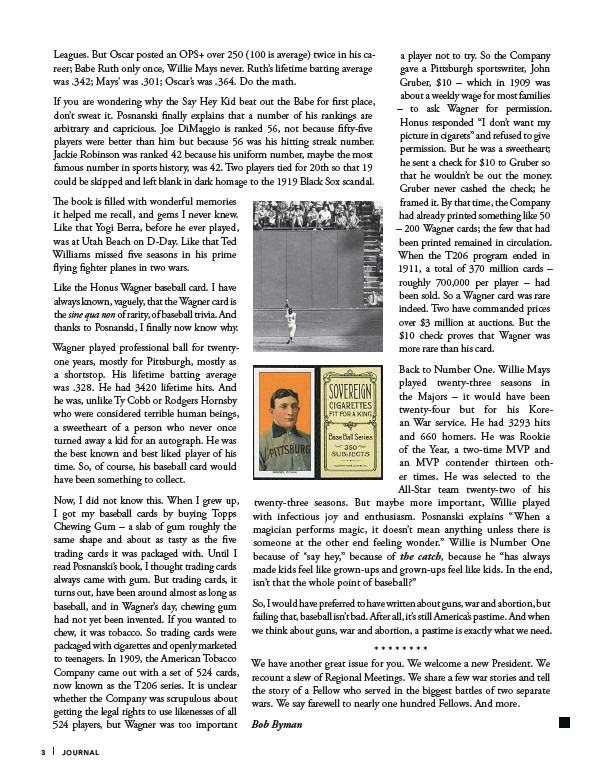
Leagues. But Oscar posted an OPS+ over 250 (100 is average) twice in his career;
Babe Ruth only once, Willie Mays never. Ruth’s lifetime batting average
was .342; Mays’ was .301; Oscar’s was .364. Do the math.
If you are wondering why the Say Hey Kid beat out the Babe for first place,
don’t sweat it. Posnanski finally explains that a number of his rankings are
arbitrary and capricious. Joe DiMaggio is ranked 56, not because fifty-five
players were better than him but because 56 was his hitting streak number.
Jackie Robinson was ranked 42 because his uniform number, maybe the most
famous number in sports history, was 42. Two players tied for 20th so that 19
could be skipped and left blank in dark homage to the 1919 Black Sox scandal.
The book is filled with wonderful memories
it helped me recall, and gems I never knew.
Like that Yogi Berra, before he ever played,
was at Utah Beach on D-Day. Like that Ted
Williams missed five seasons in his prime
flying fighter planes in two wars.
Like the Honus Wagner baseball card. I have
always known, vaguely, that the Wagner card is
the sine qua non of rarity, of baseball trivia. And
thanks to Posnanski, I finally now know why.
Wagner played professional ball for twenty-
one years, mostly for Pittsburgh, mostly as
a shortstop. His lifetime batting average
was .328. He had 3420 lifetime hits. And
he was, unlike Ty Cobb or Rodgers Hornsby
who were considered terrible human beings,
a sweetheart of a person who never once
turned away a kid for an autograph. He was
the best known and best liked player of his
time. So, of course, his baseball card would
have been something to collect.
Now, I did not know this. When I grew up,
I got my baseball cards by buying Topps
Chewing Gum – a slab of gum roughly the
same shape and about as tasty as the five
trading cards it was packaged with. Until I
read Posnanski’s book, I thought trading cards
always came with gum. But trading cards, it
turns out, have been around almost as long as
baseball, and in Wagner’s day, chewing gum
had not yet been invented. If you wanted to
chew, it was tobacco. So trading cards were
packaged with cigarettes and openly marketed
to teenagers. In 1909, the American Tobacco
Company came out with a set of 524 cards,
now known as the T206 series. It is unclear
whether the Company was scrupulous about
getting the legal rights to use likenesses of all
524 players, but Wagner was too important
a player not to try. So the Company
gave a Pittsburgh sportswriter, John
Gruber, $10 – which in 1909 was
about a weekly wage for most families
– to ask Wagner for permission.
Honus responded “I don’t want my
picture in cigarets” and refused to give
permission. But he was a sweetheart;
he sent a check for $10 to Gruber so
that he wouldn’t be out the money.
Gruber never cashed the check; he
framed it. By that time, the Company
had already printed something like 50
– 200 Wagner cards; the few that had
been printed remained in circulation.
When the T206 program ended in
1911, a total of 370 million cards –
roughly 700,000 per player – had
been sold. So a Wagner card was rare
indeed. Two have commanded prices
over $3 million at auctions. But the
$10 check proves that Wagner was
more rare than his card.
Back to Number One. Willie Mays
played twenty-three seasons in
the Majors – it would have been
twenty-four but for his Korean
War service. He had 3293 hits
and 660 homers. He was Rookie
of the Year, a two-time MVP and
an MVP contender thirteen other
times. He was selected to the
All-Star team twenty-two of his
twenty-three seasons. But maybe more important, Willie played
with infectious joy and enthusiasm. Posnanski explains “When a
magician performs magic, it doesn’t mean anything unless there is
someone at the other end feeling wonder.” Willie is Number One
because of “say hey,” because of the catch, because he “has always
made kids feel like grown-ups and grown-ups feel like kids. In the end,
isn’t that the whole point of baseball?”
So, I would have preferred to have written about guns, war and abortion, but
failing that, baseball isn’t bad. After all, it’s still America’s pastime. And when
we think about guns, war and abortion, a pastime is exactly what we need.
* * * * * * * *
We have another great issue for you. We welcome a new President. We
recount a slew of Regional Meetings. We share a few war stories and tell
the story of a Fellow who served in the biggest battles of two separate
wars. We say farewell to nearly one hundred Fellows. And more.
Bob Byman
3 JOURNAL